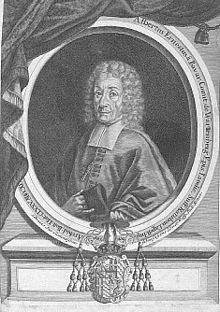Albert Ernst von Wartenberg
Albert Ernst von Wartenberg ; often Albrecht Ernst (* July 22, 1635 in Munich ; † October 9, 1715 in Regensburg ) was a Wittelsbacher from the "Ferdinandine family line" of the Counts of Wartenberg, auxiliary bishop in Regensburg or titular bishop of Laodicea in Phrygia and an early Regensburg historian .
Live and act
Lineage and Early Service
Albert Ernst von Wartenberg was the son of Count Ernst Benno von Wartenberg (curb-Bavarian treasurer and keeper of Erding) and his wife Euphrosyne Sibylle von Hohenzollern, daughter of Prince Johann von Hohenzollern-Sigmaringen . The father, Count Ernst Benno von Wartenberg, was actually a Wittelsbacher from the "Ferdinandine line" of the house, who came from the inappropriate marriage of his parents Duke Ferdinand of Bavaria and Maria von Pettenbeck , which is why he was called "Graf von Wartenberg" . The brother of Albert Ernst von Wartenberg's father was Cardinal Franz Wilhelm von Wartenberg , one of the most important German bishops of the time; his cousin, Elector Maximilian I of Bavaria .
Albert Ernst von Wartenberg received a canonical at the Regensburger Domstift in 1649 and studied at the Collegium Germanicum et Hungaricum in Rome. On August 3, 1661 he became cathedral chapter in Regensburg and was ordained a priest on March 25, 1662 . In the following year, Count von Wartenberg became the imperial court preacher in Vienna (Capellanus Imperialis) .
Auxiliary Bishop in Regensburg
1662–1715 Wartenberg was the successor of his uncle Franz Wilhelm von Wartenberg provost at the important St. Cassius monastery in Bonn. In 1687 he was appointed auxiliary bishop in Regensburg, the papal confirmation and appointment as titular bishop of Laodicea in Phrygia took place in 1688, whereupon he was given on 16 May by Eichstatt Auxiliary Bishop Franz Christoph Rinck von Baldenstein with the assistance of Abbots Johannes Ölhafen von Weltenburg and Gregor Müller of Frauenzell in Regensburg Cathedral the episcopal ordination received. In 1699 he was elected provost of the municipal collegiate monastery of St. Johann .
Wartenberg served as auxiliary bishop in Regensburg for 27 years. After the turmoil of the Thirty Years' War , the diocese was still in pretty bad shape. From the beginning, Graf Wartenberg developed extensive pastoral care and visitation activities, accompanied by intensive promotion of pilgrimages, as well as the cult of Mary and saints. He particularly tried to venerate the special Regensburg diocesan saints, such as St. Emmeram and St. Erhard, but also less known ones , such as Blessed Friedrich von Regensburg , Blessed Albert zu Oberaltaich and the blessed farmer Johannes Dätter from Griesham, whose relics he raised and let me grasp. He gave the community of Haindling a cross relic , which is still venerated there , he had the Romanesque image of the Virgin re-erected in the Regensburg Niedermünsterkirche and wrote the book about it in 1674: "Treasure chest of the most blessed virgins, Maria from Sion, origin of the wonderful foundation of the Church of ours Dear women of Niedermünster " . In the years 1675–78 he redesigned his own house chapel in Pfauengasse, today's Maria Läng chapel , into a Marian sanctuary, which is still one of the most popular places of worship in Regensburg today.
When the plague broke out in Regensburg in 1713 , in which more than 7,000 people are said to have died, wealthy and distinguished people fled the city and the episcopal curia was relocated to Wörth an der Donau . Of the high-ranking citizens, only Auxiliary Bishop Albert Ernst von Wartenberg stayed in the city to look after the sick and dying. The residents of the Stadtamhof district vowed to build a Trinity Church on the Osterberg (today Trinity Mountain); which Wartenberg consecrated in 1715.
On October 9th of the same year, Albert Ernst von Wartenberg died at the age of 79 and was buried in the cathedral. In memory of his long and fruitful pastoral work, he was given the grave inscription: "... an eye for the blind, a foot for the lame, a father for the poor ..." .
In addition to his religious duties, Auxiliary Bishop Count Wartenberg was an enthusiastic historian and wrote a. a. the 400 folio-page work: "Origin and Origin of the Vormahls Herrlich- und Königlichen Haupt Statt Noreja, anjetzo Regens-Burgg" , which is currently kept in the Regensburg State Library . He was also very interested in found antiquities and related excavations. In his manuscript on Regensburg, he describes himself as "learning about the apostolic antiquity and learning about lovers"
literature
- Anton Wilhelm Schreiber: "History of the Bavarian Duke Wilhelm V, the Pious" , Munich, 1869 Scan of the chapter on Auxiliary Bishop Albert Ernst von Wartenberg
Web links
- Website of the University of Regensburg about Auxiliary Bishop Albert Ernst von Wartenberg
- Entry on Albert Ernst von Wartenberg on catholic-hierarchy.org
Individual evidence
- ^ To Albert von Oberaltaich
- ↑ On the veneration of the farmer Johannes Dätter ( Memento from March 9, 2011 in the Internet Archive )
- ↑ On the cross relic in Haindling ( Memento from November 27, 2013 in the Internet Archive )
- ^ Website about the Maria Läng Chapel in Regensburg
- ↑ To the Church of Oath on the Dreifaltigkeitsberg
- ^ To the manuscript on Regensburg
- ↑ Website about a report by the auxiliary bishop on excavations in Regensburg
| personal data | |
|---|---|
| SURNAME | Wartenberg, Albert Ernst von |
| ALTERNATIVE NAMES | Wartenberg, Albrecht Ernst von (full name) |
| BRIEF DESCRIPTION | Auxiliary Bishop in Regensburg, historian |
| DATE OF BIRTH | July 22, 1635 |
| PLACE OF BIRTH | Munich |
| DATE OF DEATH | October 9, 1715 |
| Place of death | regensburg |

